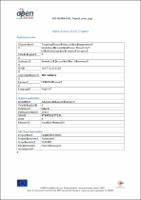Chapter 13 Targeting Tumor Perfusion and Oxygenation Modulates Hypoxia and Cancer Sensitivity to Radiotherapy and Systemic Therapies
| dc.contributor.author | Jordan, Bénédicte F. | |
| dc.contributor.author | Sonveaux, Pierre | |
| dc.date.accessioned | 2019-10-04 14:29:40 | |
| dc.date.accessioned | 2020-04-01T14:06:57Z | |
| dc.date.accessioned | 2016-08-01 23:55 | |
| dc.date.accessioned | 2019-10-04 14:29:40 | |
| dc.date.accessioned | 2020-04-01T14:06:57Z | |
| dc.date.accessioned | 2016-12-31 23:55:55 | |
| dc.date.accessioned | 2019-10-04 14:29:40 | |
| dc.date.accessioned | 2020-04-01T14:06:57Z | |
| dc.date.available | 2020-04-01T14:06:57Z | |
| dc.date.issued | 2011 | |
| dc.identifier | 612595 | |
| dc.identifier | OCN: 1030814339 | en_US |
| dc.identifier.uri | http://library.oapen.org/handle/20.500.12657/32342 | |
| dc.description.abstract | Hypoxia, a partial pressure of oxygen (pO2) below physiological needs, is a limiting factor affecting the efficiency of radiotherapy. Indeed, the reaction of reactive oxygen species (ROS, produced by water radiolysis) with DNA is readily reversible unless oxygen stabilizes the DNA lesion. While normal tissue oxygenation is around 40 mm Hg, both rodent and human tumors possess regions of tissue oxygenation below 10 mm Hg, at which tumor cells become increasingly resistant to radiation damage (radiobiological hypoxia) (Gray, 1953). Because of this so-called “oxygen enhancement effect”, the radiation dose required to achieve the same biologic effect is about three times higher in the absence of oxygen than in the presence of normal levels of oxygen (Gray et al., 1953; Horsman & van der Kogel, 2009). Hypoxic tumor cells, which are therefore more resistant to radiotherapy than well oxygenated ones, remain clonogenic and contribute to the therapeutic outcome of fractionated radiotherapy (Rojas et al., 1992). | |
| dc.language | English | |
| dc.subject.classification | thema EDItEUR::P Mathematics and Science::PD Science: general issues | en_US |
| dc.subject.other | tumor | |
| dc.subject.other | systematic therapies | |
| dc.subject.other | hypoxia | |
| dc.subject.other | radiotherapy | |
| dc.subject.other | cancer sensitivity | |
| dc.subject.other | tumor | |
| dc.subject.other | systematic therapies | |
| dc.subject.other | hypoxia | |
| dc.subject.other | radiotherapy | |
| dc.subject.other | cancer sensitivity | |
| dc.subject.other | Blood | |
| dc.subject.other | Hemodynamics | |
| dc.subject.other | Magnetic resonance imaging | |
| dc.subject.other | Neoplasm | |
| dc.subject.other | Oxygen | |
| dc.subject.other | Perfusion | |
| dc.subject.other | Radiation therapy | |
| dc.subject.other | Vasodilation | |
| dc.title | Chapter 13 Targeting Tumor Perfusion and Oxygenation Modulates Hypoxia and Cancer Sensitivity to Radiotherapy and Systemic Therapies | |
| dc.type | chapter | |
| oapen.identifier.doi | 10.5772/23332 | |
| oapen.relation.isPublishedBy | 09f6769d-48ed-467d-b150-4cf2680656a1 | |
| oapen.relation.isPartOfBook | f8819a36-74fb-4e74-ad33-23e97c839e51 | |
| oapen.relation.isFundedBy | 7292b17b-f01a-4016-94d3-d7fb5ef9fb79 | |
| oapen.collection | European Research Council (ERC) | * |
| oapen.collection | EU collection | * |
| oapen.chapternumber | 1 | |
| oapen.grant.number | 243188 | |
| oapen.grant.acronym | TUMETABO | |
| oapen.grant.program | FP7 | |
| oapen.remark.public | Relevant Wikipedia pages: Blood - https://en.wikipedia.org/wiki/Blood; Hemodynamics - https://en.wikipedia.org/wiki/Hemodynamics; Hypoxia (medical) - https://en.wikipedia.org/wiki/Hypoxia_(medical); Magnetic resonance imaging - https://en.wikipedia.org/wiki/Magnetic_resonance_imaging; Neoplasm - https://en.wikipedia.org/wiki/Neoplasm; Oxygen - https://en.wikipedia.org/wiki/Oxygen; Perfusion - https://en.wikipedia.org/wiki/Perfusion; Radiation therapy - https://en.wikipedia.org/wiki/Radiation_therapy; Vasodilation - https://en.wikipedia.org/wiki/Vasodilation | |
| oapen.identifier.ocn | 1030814339 |

